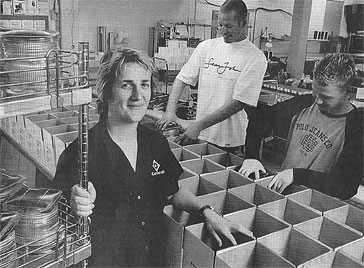VICTORIA – When Mimi Drabit arrived for work at Carmanah Technologies Inc. on Sept. 2, she thought it would be a day like any other at the small but fast-growing Victoria company, which makes, among other things, solar-powered lights.
That is, until she checked her voice-mail messages.
“The coast guard in Mobil, Alabama had left a message and I could hear the desperation in their voice,” she said.
The hurricane and flood that swept through New Orleans wiped out its transportation infrastructure. Hundreds of buoys needed to guide ships into the city’s port were lost. Railway bridge lights were out. And when the electrical grid went black, it took aircraft warning lights on towers and buildings with it.
“They needed 80 lights, and they needed them that day,” she said.
 |
|
Mimi Drabit with some of the 500 solar marine LED lights that are being shipped to the areas devastated by Hurricane Katrinal. (Photo by Diana Nethercott for National Post). |
That was just the beginning. By yesterday morning more than 500 of Carmanah’s lights, which use light emitting diode (LED) technology powered by solar panels, had arrived in Mobile at one of the only U.S. Coast Guard stations not destroyed by the hurricane. The last shipment of lights on Tuesday was so large Federal Express devoted a special plane to the task.
As New Orleans rebuilds, the experience of Carmanah shows both the opportunities and challenges that await firms tackling the multibillion-dollar construction project.
Located in a cluster of abandoned Canadian coast guard buildings in Victoria, Carmanah is a little-known company that trades on the TSX Venture Exchange. Yet it has quickly built up an impressive list of customers, including the U.S. Coast Guard and Air Force, and transit authorities in cities around the world.
Ms. Drabit, Carmanah’s coast guard liaison officer, said she has seen emergency orders before. But usually after other hurricanes only 20 or so lights were ordered. To meet this demand, she knew the company would have to put orders from its other customers on hold.
To fill that first order of 80 lights, which retail for US$1,200 each, she asked distributors to send back any lights they had, while the company’s employees franticly rushed to build the rest. By 1 p.m. that day, the full order was shipped.
Since then, that scenario has played out again and again. Ms. Drabit said the company is now two weeks behind in other orders, but that customers have been understanding.
Though the company started out making marine lights, it has branched into industrial solar powered systems and LED-lit signs. As New Orleans rebuilds, it’s clear there could be other opportunities for Carmanah to supply its low-cost, energy-efficient solar-powered products.
Even as work at Carmanah returned somewhat to normal yesterday, Ms. Drabit said she’d received another call from the coast guard in South Carolina. At one point they were facing Hurricane Ophelia, though the storm eventually turned away.
“They knew what we had done in New Orleans, and phoned to give us the heads up they might need us to ship to them, too.”
